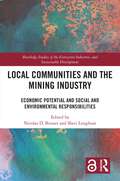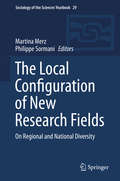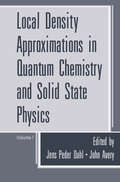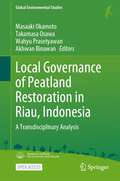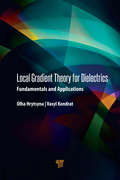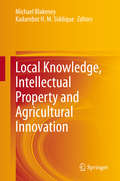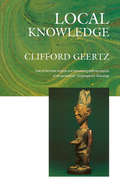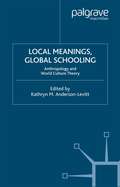- Table View
- List View
Local Communities and the Mining Industry: Economic Potential and Social and Environmental Responsibilities (Routledge Studies of the Extractive Industries and Sustainable Development)
by Nicolas D. Brunet Sheri LongboatThis book explores the challenges and opportunities at the intersection of the global mining sector and local communities by focusing on a number of international cases drawn from various locations in Canada, the Philippines, and Scandinavia. Mining’s contribution to economic development varies greatly across countries. In some, it has been a major engine of development, but in others, disputes have erupted over land use, property rights, environmental damage, and revenue sharing. Corporate social responsibility programs are increasingly relied upon to manage company-community relations, yet conflicts persist in many settings, with significant costs for companies and communities. Exploring the many factors and drivers that characterize relationships among different actors within the sector, the volume contributes towards the development of practical wisdom, collective understanding, common sense, and prudence required for the mining sector and community partners to realize the economic potential and social and environmental responsibilities of non-renewable resource development. The book examines case studies from Canada, Scandinavia, and the Philippines, three regions amongst the world's top countries of mining operations. Drawing on their extensive experience in these regions, the contributors explore distinctive mining sectors in the Global North and South, the variation surrounding different types of extractive industries, and at different scales, and the legal processes in place to protect local communities. Key themes include corporate social responsibility, impact assessment, foreign ownership, Indigenous Peoples, gender, local insurgency, and mining disasters as well as climate change. The book identifies areas of future research and pathways to achieving stronger, respectful, and mutually beneficial relationships at the nexus of global mineral extraction and local communities. This book will be of great interest to students and scholars of the extractive industries, natural resource management, sustainable business and corporate social responsibility, Indigenous studies, and sustainable planning and development.
Local Communities and the Mining Industry: Economic Potential and Social and Environmental Responsibilities (Routledge Studies of the Extractive Industries and Sustainable Development)
This book explores the challenges and opportunities at the intersection of the global mining sector and local communities by focusing on a number of international cases drawn from various locations in Canada, the Philippines, and Scandinavia. Mining’s contribution to economic development varies greatly across countries. In some, it has been a major engine of development, but in others, disputes have erupted over land use, property rights, environmental damage, and revenue sharing. Corporate social responsibility programs are increasingly relied upon to manage company-community relations, yet conflicts persist in many settings, with significant costs for companies and communities. Exploring the many factors and drivers that characterize relationships among different actors within the sector, the volume contributes towards the development of practical wisdom, collective understanding, common sense, and prudence required for the mining sector and community partners to realize the economic potential and social and environmental responsibilities of non-renewable resource development. The book examines case studies from Canada, Scandinavia, and the Philippines, three regions amongst the world's top countries of mining operations. Drawing on their extensive experience in these regions, the contributors explore distinctive mining sectors in the Global North and South, the variation surrounding different types of extractive industries, and at different scales, and the legal processes in place to protect local communities. Key themes include corporate social responsibility, impact assessment, foreign ownership, Indigenous Peoples, gender, local insurgency, and mining disasters as well as climate change. The book identifies areas of future research and pathways to achieving stronger, respectful, and mutually beneficial relationships at the nexus of global mineral extraction and local communities. This book will be of great interest to students and scholars of the extractive industries, natural resource management, sustainable business and corporate social responsibility, Indigenous studies, and sustainable planning and development.
The Local Configuration of New Research Fields: On Regional and National Diversity (Sociology of the Sciences Yearbook #29)
by Martina Merz Philippe SormaniThis new Yearbook addresses the question of how policy, place, and organization are made to matter for a new research field to emerge. Bringing together leading historians, sociologists, and organizational researchers on science and technology, the volume answers this question by offering in-depth case studies and comparative perspectives on multiple research fields in their nascent stage, including molecular biology and materials science, nanotechnology, and synthetic biology. The Yearbook brings to bear the lessons of constructivist ethnography and the “practice turn” in Science and Technology Studies (STS) more broadly on the qualitative, comparative, and critical inquiry of new research fields. In doing so, it offers unprecedented insights into the complex interplay of national research policies, regional clusters, particular research institutions, and novel research practices in and for any emerging field of (techno-)science. It systematically investigates national and regional differences, including the variable mobilization of such differences, and probes them for organizational topicality and policy relevance.
Local Density Approximations in Quantum Chemistry and Solid State Physics
by Jens Peder Dahl John AveryThe· simplest picture of an atom, a molecule or a solid is the picture of its distribution of charge. It is obtained by specifying the positions of the atomic nuclei and by showing how the density, p(E), of the electronic charge-cloud varies from place to place. A much more detailed picture is provided by the many-electron wavefunction. This quantity shows not only the arrangement of the electrons with respect to the nuclei, but also the arrangement of the electrons with respect to each other, and it allows the evaluation of the total energy and other properties. The many-electron wavefunction is in principle obtained by solving the many-electron Schrodinger equation for the motion of the interacting electrons under the influ ence of the nuclei, but in practice the equation is unsolvable, and it is necessary to proceed by methods of approximation. Needless to say, .such methods will as a rule depend on the complexity of the system considered.
Local Density Theory of Polarizability (Physics of Solids and Liquids)
by Gerald D. Mahan K.R. SubbaswamyDuring the past decade the theoretical physics community has learned how to evaluate accurately polarizabilities and susceptibilities for many-electron systems such as atoms, solids, and liquids. The most accurate numerical technique employs a method often called the Time-Dependent Local Density Approximation, which is abbreviated TDLDA. The present volume is a review of recent research on the theory of po larizabilities and susceptibilities. Both authors have been doing these cal culations. However, this review surveys the entire field, summarizing the research of many contributors. The application of an external field, either ac or de, will induce a dipole moment which can be calculated and compared with experiment. For mod erately strong fields, both linear and nonlinear processes contribute to the moment. We cover topics such as polarizability, hyperpolarizability, pho toionization, phonons, and piezoelectricity. Density functional theory in the Local Density Approximation (LDA) has been shown to be a very accurate method for calculating ground state prop erties of electronic system. For static external fields, the induced moments are properties of the ground state. Then the calculation of the polarizability · is very accurate. For ac fields, the moment is not part of the ground state. However, the TDLDA methods are still very accurate.
Local Disaster Risk Management in a Changing Climate: Perspective from Central America (Community, Environment and Disaster Risk Management #17)
by Hori Tsuneki Rajib Shaw"Disasters cause economic as well as human losses. Indeed, economic losses associated directly with disasters have continued at increasing proportions worldwide since the 1970s, as the 2011 Global Assessment Report on Disaster Risk Reduction conducted by the United Nations International Strategy for Disaster Reduction (UNISDR) illustrates. Disaster losses due to single geological events sometimes appear much greater in magnitude than those attributed to climate-related disasters. Nonetheless, the overall trend for increasing loss can largely be attributed to the increase in climate-related disasters, which in turn is triggered in part by global climate change. Furthermore, as such disasters increase in frequency, it intensifies vulnerability in the poorest regions of developing countries. In this book, the authors discuss effective approaches to enhancing the local disaster risk management (DRM) capacity of developing countries to combat increasing climate-related disaster impacts. Also provided are ideas and lessons on local disaster risk management, in terms of planning and practice in developing countries, with particular focus on a case study in Costa Rica."
Local Electrode Atom Probe Tomography: A User's Guide
by David J. Larson Ty J. Prosa Robert M. Ulfig Brian P. Geiser Thomas F. KellyThis book is the first, single-source guide to successful experiments using the local electrode atom probe (LEAP®) microscope. Coverage is both comprehensive and user friendly, including the fundamentals of preparing specimens for the microscope from a variety of materials, the details of the instrumentation used in data collection, the parameters under which optimal data are collected, the current methods of data reconstruction, and selected methods of data analysis. Tricks of the trade are described that are often learned only through trial and error, allowing users to succeed much more quickly in the challenging areas of specimen preparation and data collection. A closing chapter on applications presents selected, state-of-the-art results using the LEAP microscope.
Local Emergency Planning Committee Guidebook: Understanding the EPA Risk Management Program Rule (A CCPS Concept Book #19)
by R. J. WalterMembers of the community who serve on LEPC’s are on the frontlines when it comes to responding effectively to incidents that may occur in local facilities handling hazardous materials. This book provides practical, solid information to assist them in formulating effective plans to respond to emergencies and reduce potential risks to the public.
Local Energy Autonomy: Spaces, Scales, Politics
by Fanny Lopez Margot Pellegrino Olivier CoutardIn recent years, interest for local energy production, supply and consumption has increased in academic and public debates. In particular, contemporary energy transition discourses and strategies often emphasize the search for increased local energy autonomy, a phrase which can refer to a diverse range of configurations, both in terms of the spaces and scales of the local territory considered and in terms of what is meant by energy autonomy. This book explores policies, projects and processes aimed at increased local energy autonomy, with a particular focus on their spatial, infrastructural and political dimensions. In doing so, the authors – Sabine Barles, Bruno Barroca, Guilhem Blanchard, Benoit Boutaud, Arwen Colell, Gilles Debizet, Ariane Debourdeau, Laure Dobigny, Florian Dupont, Zélia Hampikian, Sylvy Jaglin, Allan Jones, Raphael Ménard, Alain Nadaï, Angela Pohlmann, Cyril Roger-Lacan, Eric Vidalenc – improve our understanding of the always partial and controversial processes of energy relocation that articulate forms of local metabolic self-sufficiency, socio-technical decentralization and political empowerment. Comprising fifteen chapters, the book is divided into four parts: Governance and Actors; Urban Projects and Energy Systems; Energy Communities; and The Challenges of Energy Autonomy.
Local Energy Autonomy: Spaces, Scales, Politics
by Fanny Lopez Margot Pellegrino Olivier CoutardIn recent years, interest for local energy production, supply and consumption has increased in academic and public debates. In particular, contemporary energy transition discourses and strategies often emphasize the search for increased local energy autonomy, a phrase which can refer to a diverse range of configurations, both in terms of the spaces and scales of the local territory considered and in terms of what is meant by energy autonomy. This book explores policies, projects and processes aimed at increased local energy autonomy, with a particular focus on their spatial, infrastructural and political dimensions. In doing so, the authors – Sabine Barles, Bruno Barroca, Guilhem Blanchard, Benoit Boutaud, Arwen Colell, Gilles Debizet, Ariane Debourdeau, Laure Dobigny, Florian Dupont, Zélia Hampikian, Sylvy Jaglin, Allan Jones, Raphael Ménard, Alain Nadaï, Angela Pohlmann, Cyril Roger-Lacan, Eric Vidalenc – improve our understanding of the always partial and controversial processes of energy relocation that articulate forms of local metabolic self-sufficiency, socio-technical decentralization and political empowerment. Comprising fifteen chapters, the book is divided into four parts: Governance and Actors; Urban Projects and Energy Systems; Energy Communities; and The Challenges of Energy Autonomy.
Local Environmental Change and Society in Africa
by M.A. Mohamed SalihSocial and natural scientists are currently obsessed with globalization, but this has not been matched by an equal interest in the societal consequences of local environmental change. Attention has thus been withdrawn from community and locality and transferred to global processes, with an indifference to the reality of those at the receiving end of the social, economic and political problems that globalization create. Local reality is obscured and conditions are imposed that are often insensitive to or even distort local needs, resource management, and production systems. The case studies presented here illustrate how environmental degradation has contributed to the distortion of local institutions and economies, thus denying local communities the right to live in a productive and healthy environment. The contributors highlight the seriousness of the difficulties involved in conflating national policies and local reality, and imposing global policy instruments on local communities. Understandably, the case studies demonstrate that local communities resist putting their faith in environmental policies and plans imposed on them by global or national institutions that often deprive them of access to and control over their local environment.
Local Environmental Change and Society in Africa
by M. A. MohamedSalihThe Organization for Social Science Research in Eastern and Southern Africa (OSSREA) is a network of social scientists in the sub-region established in 1980. Its main objectives are to encourage and promote interest; to engage in collaborative research; to facilitate scholarly exchange of ideas and publication between individuals and institutions engaged in the study and research in the social sciences. OSSREA also aims to promote the training of social scientists from the sub-region in the study of and research in the social sciences and to encourage establishment of institutions dedicated to this goal. In pursuance of and consistent with its objectives, OSSREA established a fund to provide research grants and training fellowships to social scientists from the sub-region. Every year OSSREA offers, on a competitive basis, two limited types of research grants: the first on topics related to the social sciences in general and the second on gender issues in particular. The grants assist the social scientists to conduct field research in an eastern or southern African country, society, institutions, sector, or problem area. The objectives of the social science competition are intended to encourage and promote upcoming scholars from the sub-region to conduct research in the social, economic, political or other problems. Moreover, it aims to strengthen and raise the capacity of faculty members and students in field research, and promote the subsequent availability of research fmdings for teaching as well as to inform individuals and institutions.
Local Food Plants of Brazil (Ethnobiology)
by Michelle Cristine Medeiros Jacob Ulysses Paulino AlbuquerqueThere has been growing academic interest in local food plants. This is a subject that lies at the frontiers of knowledge of various areas, such as environmental sciences, nutrition, public health, and humanities. To date, however, we do not have a book bringing these multi-disciplinary perspectives to bear on this complex field. This book presents the current state of knowledge on local Brazilian food plants through a multidisciplinary approach, including an overview of food plants in Brazil, as well as comprehensive nutritional data. It compiles basic theories on the interrelationship between biodiversity and food and nutrition security, as well as ethnobotanical knowledge of local Brazilian food plants. Additionally, this title provides various methods of learning and teaching the subject, including through social media, artificial intelligence, and through workshops, among others.
Local Governance of Peatland Restoration in Riau, Indonesia: A Transdisciplinary Analysis (Global Environmental Studies)
by Masaaki Okamoto Takamasa Osawa Wahyu Prasetyawan Akhwan BinawanThis open access book is one in a series of four volumes introducing peatland conservation and restoration in Indonesia. It focuses on local governance, in particular on regional and local perspectives in Riau, the most peat-destructed province of Indonesia. The book fills a vital gap in the existing literature that overlooks social science and humanities perspectives. Written by authors from different disciplines and backgrounds (including scholars and NGO activists), the approaches to the topic are various and unique, including analysis of GPS logs, social media, geospatial assessments, online interviews (conducted due to the Covid-19 pandemic), and more conventional questionnaires and surveys of community members. The chapters cover an interdisciplinary understanding of peatland destruction and broadly offer insights into environmental governance. While presenting combined studies of established fieldwork methodologies and contemporary technology such as drones and geospatial information, the book also explores the potential of long-distance research with rural communities through online facilitation, which was brought about by Covid-19, but that may have longterm implications. Readers will gain a comprehensive understanding of the complexities surrounding peatland conservation and restoration and recognize the significance of locally inclusive approaches that use contemporary but accessible technologies to sustainably govern the globally important resource of peatland. That approach would be useful for other environmentally fragile but important regions and give some ideas to achieve the United Nations’ SDGs for 1)No Poverty, 5)Gender Equality, 13)Climate Action, 15)Life of Land.
Local Government (Reviews of United Kingdom Statistical Sources #24)
by J. GillsepieThe Sources and Nature of the Statistics of the United Kingdom, produced under the auspices of the Royal S~atistical Society and edited by Maurice Kendall, filled a notable gap on the library shelves when it made its appearance in the early post-war years. Through a series of critical reviews by many of the foremost national experts, it constituted a valuable contemporary guide to statisticians working in many fields as well as a bench-mark to which historians of the development of Statistics in this country are likely to return again and again. The Social Science Research Council* and the Society were both delighted when Professor Maunder came forward with the proposal that a revised version should be produced, indicating as well his willingness to take on the onerous task of editor. The two bodies were more than happy to act as co-sponsors of the project and to help in its planning through a joint steering committee. The result, we are confident, will be judged a worthy successor to the previous volumes by the very much larger 'statistics public' that has come into being in the intervening years. Mrs SUZANNE REEVE Mrs EJ. SNELL Secretary Honorary Secretary Economic and Social Research Council Royal Statistical Society *SSRC is now the Economic and Social Research Council (ESRC). vii MEMBERSHIP OF JOINT STEERING COMMITTEE (November 1986) Chairman: Miss S. V. Cunliffe Representing the Royal Statistical Society: Mr M. C. Fessey Dr S. Rosenbaum Mrs E. J.
Local Government and Urban Governance in Europe (The Urban Book Series)
by Carlos Nunes Silva Ján BučekThis book discusses innovative responses and reforms developed in critical areas of urban governance in European countries. It examines the impact of European Union’s policies on the urban agenda and on local governance, and the impact of the transition to democracy in Central and in Southern Europe on local self-government systems. The book is divided into three parts: i) Crisis, Reform and Innovation in Local Government; ii) EU Policies, the Urban Agenda and Local Governance; and iii) Citizen Participation in Local Government. Providing an extensive and updated overview of key challenges in the governance of cities in Europe, the book will be of interest to students and researchers in the broader field of urban studies, and for policy-makers, especially those engaged in urban governance in European countries.
Local Governments and Climate Change: Sustainable Energy Planning and Implementation in Small and Medium Sized Communities (Advances in Global Change Research #39)
by Maryke Van Staden Francesco MuscoGlobal warming is changing the world as we know it. Climate change can have catastrophic impacts in numerous cities across the world. It is time for us to react – quickly and effectively. The European Community (EC) has been leading the fight against climate change, making it one of its top priorities. We have introduced the most ambitious targets of their kind, known as the “20/20/20 by 2020” initiative within the “Climate Action and Renewable Energy Package.” As a result, European Member States have taken on a commitment to curb their CO emissions by at least 20% by 2020. 2 These targets are indeed commendable; however, they are only the start if we are to avoid the consequences of global warming. Whilst top level coordination from the European Institutions and Member State governments is vital, the role of mitigating and adapting to climate change at local level must not be forgotten. In fact, here cities, regions and their citizens play a significant a role. It is therefore vital they become directly involved in the climate change challenge. The European Commission therefore launched in 2008 a new initiative, the Covenant of Mayors, which brings together a network of European mayors in a voluntary effort to go beyond the European Union’s already ambitious targets. Half of our greenhouse gas emissions (GHGs) are created in and by cities.
Local Gradient Theory for Dielectrics: Fundamentals and Applications
by Olha Hrytsyna Vasyl KondratThis book is devoted to the development of the local gradient theory of dielectrics. It presents a brief description of the known approaches to the construction of generalized (integral- and gradient-type) continuous theories of dielectrics. It describes a new continuum–thermodynamic approach to the construction of nonlinear high-order gradient theory of thermoelastic non-ferromagnetic polarized media. This approach is based on accounting for non-diffusive and non-convective mass fluxes associated with the changes in the material microstructure. Within the linear approximation, the theory has been applied to study transition modes of the formation of near-surface inhomogeneity of coupled fields in solids, disjoining pressure in thin films, etc. The theory describes a number of observable phenomena (including the surface, size, flexoelectric, pyroelectric, and thermopolarization effects in centrosymmetric crystals, the Meads anomaly, the high frequency dispersion of elastic waves, etc.) that cannot be explained within the framework of the classical theory of dielectrics.
Local Gradient Theory for Dielectrics: Fundamentals and Applications
by Olha Hrytsyna Vasyl KondratThis book is devoted to the development of the local gradient theory of dielectrics. It presents a brief description of the known approaches to the construction of generalized (integral- and gradient-type) continuous theories of dielectrics. It describes a new continuum–thermodynamic approach to the construction of nonlinear high-order gradient theory of thermoelastic non-ferromagnetic polarized media. This approach is based on accounting for non-diffusive and non-convective mass fluxes associated with the changes in the material microstructure. Within the linear approximation, the theory has been applied to study transition modes of the formation of near-surface inhomogeneity of coupled fields in solids, disjoining pressure in thin films, etc. The theory describes a number of observable phenomena (including the surface, size, flexoelectric, pyroelectric, and thermopolarization effects in centrosymmetric crystals, the Meads anomaly, the high frequency dispersion of elastic waves, etc.) that cannot be explained within the framework of the classical theory of dielectrics.
Local Induction (Synthese Library #93)
by R. BogdanThe local justification of beliefs and hypotheses has recently become a major concern for epistemologists and philosophers of induction. As such, the problem of local justification is not entirely new. Most pragmatists had addressed themselves to it, and so did, to some extent, many classical inductivists in the Bacon-Whewell-Mill tradition. In the last few decades, however, the use of logic and semantics, probability calculus, statistical methods, and decision-theoretic concepts in the reconstruction of in ductive inference has revealed some important technical respects in which inductive justification can be local: the choice of a language, with its syntactic and semantic features, the relativity of probabilistic evalua tions to an initial body of evidence or background knowledge and to an agent's utilities and preferences, etc. Some paradoxes and difficulties encountered by purely formal accounts of inductive justification, the erosion of the once dominant empiricist position, which most approaches to induction took for granted, and the increasing challenge of noninduc tivist epistemolgies have underscored the need of accounting for the methodological problems of applying inductive logic to real life contexts, particularly in science. As a result, in the late fifties and sixties, several related developments pointed to a new, local approach to inductive justification.
Local Knowledge, Intellectual Property and Agricultural Innovation
by Michael Blakeney Kadambot H. M. SiddiqueThis book examines the role of local knowledge in promoting agricultural innovation and legislative support for agricultural innovation through intellectual property laws and the protection of farmers’ rights. In assessing the role of intellectual property in promoting agricultural innovation the book examines plant variety rights protection, the patenting of plant varieties and plant breeding methods; gene patents and climate change; open source biotechnology and agricultural innovation and geographical indications and the marketing of agricultural products. As a test bed for the application of the themes of the book, it applies a case study approach to look at the role of local knowledge and intellectual property rights in the cultivation of traditional rice varieties in Kerala, South West India and the extent to which this cultivation is supported by Indian legislation. The book concludes with an examination of the success of self-help groups, such as Farmers’ Clubs. This book appeals to all readers interested in policies to promote sustainable agriculture at a time of increasing food insecurity. A special feature of the book is the case study approach. To date, the role of local knowledge and agricultural innovation has been almost entirely ignored and the role of intellectual property in this space has been largely ignored. The book is a result of a research collaboration between the University of Western Australia and Kerala Agricultural University, funded in part by the Australian Research Council.
Local Knowledge (Text Only): Further Essays In Interpretive Anthropology
by Clifford GeertzThe noted cultural anthropologist and author of 'The Interpretation of Cultures' deepens our understanding of human societies through the intimacies of 'local knowledge.'
Local Meanings, Global Schooling: Anthropology and World Culture Theory
by K. Anderson-LevittIs there one global culture of schooling, or many national and local cultures? Do educational reforms take school systems on diverging or parallel paths? These case studies from five continents use ethnography and history to challenge the sweeping claims of sociology's world culture theory (neo-institutionalism). They demonstrate how national ministries of education and local schools re-invent every reform. Yet the cases also show that teachers and local reformers operate 'within and against' global models. Anthropologists need to recognize the global presence in local schooling as well as local transformation of global models. This is a collection that scholars in the field of the anthropology of education will not want to be without.
Local Planning for Terror and Disaster: From Bioterrorism to Earthquakes
by Leonard A. Cole Nancy D. ConnellLocal Planning for Terror and Disaster gives voice to experts in key fields involved with local preparedness, assessing the quality of preparedness in each field, and offering directions for improvement. Introductory chapters provide overviews of terror medicine, security and communications, which are indispensable to successful preparedness, while subsequent chapters concentrate on a particular field and how responders from that field communicate and interact with others during and after an event. Thus, a chapter by a physician discusses not only the doctor's role but how that role is, or should be, coordinated with emergency medical technicians and police. Similarly, chapters by law enforcement figures also review police responsibilities and interactions with nurses, EMTs, volunteers and other relevant responders. Developed from topics at recent Symposia on Terror Medicine and Security, Local Planning also encompasses aspects of emergency and disaster medicine, as well as techniques for diagnosis, rescue, coordination and security that are distinctive to a terrorist attack. Each chapter also includes a case study that demonstrates preparedness, or lack thereof, for a real or hypothetical event, including lessons learned, next steps, and areas for improvement in this global era which increasingly calls for preparedness at a local level.
Local Planning for Terror and Disaster: From Bioterrorism to Earthquakes
by Leonard A. Cole Nancy D. ConnellLocal Planning for Terror and Disaster gives voice to experts in key fields involved with local preparedness, assessing the quality of preparedness in each field, and offering directions for improvement. Introductory chapters provide overviews of terror medicine, security and communications, which are indispensable to successful preparedness, while subsequent chapters concentrate on a particular field and how responders from that field communicate and interact with others during and after an event. Thus, a chapter by a physician discusses not only the doctor's role but how that role is, or should be, coordinated with emergency medical technicians and police. Similarly, chapters by law enforcement figures also review police responsibilities and interactions with nurses, EMTs, volunteers and other relevant responders. Developed from topics at recent Symposia on Terror Medicine and Security, Local Planning also encompasses aspects of emergency and disaster medicine, as well as techniques for diagnosis, rescue, coordination and security that are distinctive to a terrorist attack. Each chapter also includes a case study that demonstrates preparedness, or lack thereof, for a real or hypothetical event, including lessons learned, next steps, and areas for improvement in this global era which increasingly calls for preparedness at a local level.
